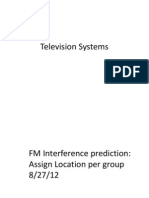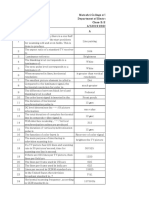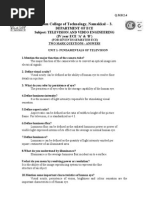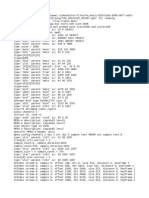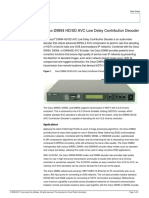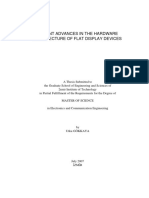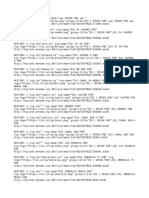DAR ES SALAAM INSTITUTE OF TECHNOLOGY
(DIT)
DEPARTMENT OF ELECTRONICS AND TELECOMMUNICATION
ENGINEERING
TASK: GROUP ASSIGNMENTS 1 & 2
MODULE NAME: TELEVISION ENGINEERING
MODULE CODE: ETU 07622
MODULE MASTER: Dr. ASINTA MANYELE
CLASS: BENG22ETE-2
ACADEMIC YEAR: 2024/2025
GROUP No. 03 - MEMBERS
NAME REGISTRATION NUMBER
INNOCENT EDGAR USHAKI 220647481539
JOSHUA EMMANUEL MANJALE 220647431591
NOVATH PROCHES MARTINIAN 220647456093
MICHAEL AMOSY NYAGINDU 220647402949
KULWA SHALU 220647403459
Page i of 14
�ASSIGNMENT 1
Qn. 1. Why is picture frame frequency of 25 frames per second in Tanzania and 30 per
second in USA?
Logic behind
The frame rate is synchronized with the AC mains frequency in each region. In Tanzania (and
many European countries), the mains is 50 Hz, so half of that value (25 fps) is used to minimize
flicker. In the USA (and similar regions), the mains is 60 Hz, so half (30 fps) is used for the same
purpose.
Answer: the difference is due to the power supply frequency. Tanzania uses a 50Hz power
system, while the USA uses 60 Hz, frame frequency is synchronized with the mains frequency to
avoid flicker and interference there fore
- Tanzania: 50 Hz mains → 50/2 = 25 fps.
- USA: 60 Hz mains → 60/2 = 30 fps.
Qn. 2. Why is flicker not removed by progressive scanning?
Flicker is not removed by progressive scanning because,
a) Progressive scanning displays one full frame at a time, scanning all lines in sequence
from top to bottom.
b) When only 25 to 30 full frames per second are displayed (as in many standard systems),
the dark interval between the display of each frame becomes noticeable to the human eye,
especially in brighter areas of the image.
c) The persistence of vision decreases with brightness, meaning the brighter the scene, the
more noticeable the flicker when the screen goes dark between frames.
Page 1 of 14
�Qn. 3. Why is the number of scanning lines per frame always odd?
Answer:
To facilitate interlaced scanning, the number of lines must be odd (525, 625). This allows the
first field to scan odd lines and the second field to scan even lines, resulting in a full frame when
both fields are combined.
Qn. 4. Why is the vertical deflection very slow compared to horizontal deflection?
Answer:
Horizontal deflection operates at ~15,750Hz (525-line) or ~15,625Hz (625-line) systems,
completing each line in microseconds. Vertical deflection runs at 50/60Hz (field rate), taking
milliseconds per sweep. This matches the image's width-to-height ratio, hence vertical deflection
is slower.
Qn. 5. Why are sync pulses needed in TV systems?
Sync pulses ensure the receiver’s scanning is synchronized with the transmitter, avoiding image
distortion. They are sent during retrace intervals for both horizontal and vertical scans and by
ensuring that horizontal and vertical scanning occurs at the correct times, maintains image
stability and preventing drift.
Qn. 6. Why is retrace blanked?
Answer:
During the retrace period, the electron beam in a CRT TV returns from the end of one scan line
to the beginning of the next. If this were visible, it would display unwanted lines or artifacts on
the screen.
Retrace blanking functions to:
• Eliminate visible return lines on screen
• Provide interference-free time for beam repositioning
• Allow insertion of synchronization signals
• Prevent display artifacts during beam reset
Page 2 of 14
�Qn. 7. Why is AMVSB preferred to FM for transmission of video signals?
Answer:
AMVSB (Amplitude Modulation with Vestigial Sideband) is preferred over FM (Frequency
Modulation) for the transmission of video signals mainly due to bandwidth efficiency and
simplicity of receiver design.
Reasons why AMVSB is preferred:
a) Bandwidth Conservation
• Ordinary AM requires double the video bandwidth due to two identical sidebands.
• AMVSB suppresses most of one sideband (usually the lower one) while keeping the
other intact-this saves bandwidth significantly.
• FM, on the other hand, requires a much larger bandwidth for video, which is not
practical for television broadcasting.
b) Simpler Receiver Design
• AMVSB allows the use of simple diode detectors at the receiver end.
• Pure SSB (Single Sideband) would save more bandwidth, but it requires complex
synchronous detectors, which are more expensive.
• FM detection is also more complex for video due to its large frequency swing and
need for high linearity.
c) Low-Frequency Content
• In video signals, low-frequency components are critical (example slow brightness
changes).
• FM is not ideal for low-frequency signals as it introduces distortion.
• AMVSB handles this better by retaining the lower part of one sideband (the vestige).
d) Compatibility and Standards
• Television broadcasting standards (like PAL and NTSC) were developed with
AMVSB for video and FM only for sound.
• This separation ensures minimal interference between video and audio.
Page 3 of 14
�Qn. 8. Why is SECAM system called sequential?
SECAM sends color difference signals (R–Y and B–Y) one after another per line, using a
memory delay line at the receiver, hence 'sequential'. It sends one color difference signal at a
time, and the receiver stores the data to reconstruct the full color image. This sequential process
gives the system its name.
Qn. 9. What happens if 625- or 525-line TV is viewed on a 1-metre screen?
Answer:
The resolution might appear poor or pixelated if the screen is large and viewed closely due to
limited lines/pixels.
Generally, On a 1-meter screen:
• Scanning lines become visibly apparent
• Limited resolution causes noticeable pixelation
• Aspect ratio distortion may occur without scaling
• Kell effect (visible line structure) intensifies
Qn. 10. How is the problem of cross-talk interference removed in HDTV?
Answer:
HDTV minimizes crosstalk through:
• Digital transmission with error correction
• Component video (separate luminance/chrominance)
• Increased bandwidth and resolution
• Advanced digital filtering techniques
• Precise synchronization methods
Page 4 of 14
�Qn. 11. What is the difference between a TV receiver and a video monitor?
Comparison (4 Key Points):
1. Functionality and Tuning:
- TV Receiver: Contains an internal tuner and demodulator to receive and decode broadcast
signals directly from an antenna or cable while video monitor Lacks an internal tuner; it displays
video signals fed from external sources (e.g., computers, cameras).
2. Signal Processing:
- TV Receiver: Processes RF signals into video and audio through its internal circuitry while
video monitor does not perform any signal processing; it only displays signals already processed
and provided by another device.
3. Connectivity and Inputs:
- TV Receiver: Provides inputs for broadcast sources (antenna, cable) and may offer additional
inputs (composite, HDMI) for a variety of signals while video Monitor: Focuses on high-quality
digital inputs (HDMI, DisplayPort, VGA) optimized for computer or other digital video sources.
4. Intended Usage and Optimization:
- TV Receiver: Designed for longer viewing distances with features like built‑in speakers and
channel scanning, making it suitable for home television viewing while video Monitor:
Optimized for close‑up use with higher resolution, faster refresh rates, and accurate color
reproduction, ideal for computer work, gaming, and professional applications.
thus
A TV receiver processes and decodes broadcast signals (with an internal tuner), while a video
monitor is solely for displaying pre‑processed video inputs from external devices.
Page 5 of 14
�ASSIGNMENT 2
Qn. 1. If aspect ratio is 4:3 in a conventional TV and 16:9 in an HDTV, calculate width and
height for 100 cm size screen for both TV system.
Given an aspect ratio of Width: Height = W: H, and diagonal D = 100 cm,
Pythagorean theorem is used:
Diagonal2 = Width2 + Height 2
𝑊𝑊𝑊𝑊𝑊𝑊𝑊𝑊ℎ = 𝑥𝑥 ⋅ 𝑊𝑊, 𝐻𝐻𝐻𝐻𝐻𝐻𝐻𝐻ℎ𝑡𝑡 = 𝑥𝑥 ⋅ 𝐻𝐻
D2 = X 2 ⋅ (𝑊𝑊 2 + 𝐻𝐻 2 )
D
𝑥𝑥 =
√𝑊𝑊 2 + H 2
i. Conventional TV (Aspect Ratio 4:3)
𝑊𝑊=4, 𝐻𝐻=3
𝐷𝐷=100cm
100
𝑥𝑥 =
√42 + 32
100
𝑥𝑥 =
√25
100
𝑥𝑥 =
5
𝑥𝑥 = 20
𝑊𝑊𝑊𝑊𝑊𝑊𝑊𝑊ℎ = 4𝑥𝑥 = 4 𝑋𝑋 20 = 𝟖𝟖𝟖𝟖𝟖𝟖𝟖𝟖
𝐻𝐻𝐻𝐻𝐻𝐻𝐻𝐻ℎ𝑡𝑡 = 3𝑥𝑥 = 3 𝑋𝑋 20 = 𝟔𝟔𝟔𝟔𝟔𝟔𝟔𝟔
Page 6 of 14
� ii. HDTV (Aspect Ratio 16:9)
𝑊𝑊=16, 𝐻𝐻=9
100
𝑥𝑥 =
√162 + 92
100
𝑥𝑥 =
√337
100
𝑥𝑥 = ≈ 5.45
18.36
𝑊𝑊𝑊𝑊𝑊𝑊𝑊𝑊ℎ = 16𝑥𝑥 = 16 𝑋𝑋 5.45 ≈ 87.2 cm
𝐻𝐻𝐻𝐻𝐻𝐻𝐻𝐻ℎ𝑡𝑡 = 9𝑥𝑥 = 9 𝑋𝑋 5.45 ≈ 49.1 cm
TV Type Width (cm) Height (cm)
4:3 (Conventional TV) 80 60
16:9 (HDTV) 87.2 49.1
Page 7 of 14
�Qn. 2. Calculate number of lines (n) per frame to subtend an angle of 1 minute by a space
S= n/h at distance of 4 times the height h of screen.
Answer:
Given:
• Viewing distance (D) = 4 × screen height (h)
• Angular resolution = 1 arcminute = (1/60)0
Solution:
1. Total vertical viewing angle (θ):
θ = arctan(h/D) = arctan(h/4h) ≈ 14.040
2. Number of resolvable lines (n):
n = θ / angular resolution
Therefore, number of lines (n) per frame = 14.04∘ / (1/60)∘ ≈ 842 lines
Qn. 3. Bandwidth Calculation for TV System
Given:
• Lines/frame (N) = 625
• Frame rate (F) = 25Hz
• Horizontal retrace time = 12.5μs
• Vertical blanking time = 1280μs
• Kell factor (K) = 0.72
Page 8 of 14
�Solution:
From Bandwidth, B = Rh x (N x F) / 2
Where; Rh = Horizontal resolution,
N = Lines/frame
F = Frame rate
Active lines per frame:
Lines lost = tvblank/Line time = 1280μs/64μs ≈ 20 lines/field(×2 fields = 40 lines/frame)
Active lines = 625 − 40 = 585
Active time per line:
tactive = 64μs−12.5μs=51.5μs
Horizontal resolution (Rh):
Rh = K x (tactive / tline) x N / 2 = 0.72 x (51.5 / 64) x 312.5 ≈182 cycles/line
Bandwith (B): B = Rh x (N x F) / 2 = 182 x (625 x 25) / 2 ≈5.68 MHz
Therefore, Bandwith (B) ≈5.68 MHz
Qn. 4. Calculate vertical resolution of a TV system, having 5.5 MHz bandwidth and 52 ms
trace time.
Answer:
Vertical Resolution
Vertical resolution = (Bandwidth x trace time x 10^6) x Kell factor
= 5.5 MHz x 52e-6 x 0.72
Therefore, vertical resolution = 206.8 lines (approx)
Page 9 of 14
�Qn. 5. Calculate the bandwidth for a system in which Rh = 520 and t = 52 μs (CCIR‑B
system)
Solution
Formula: BW = Rh/t
Where;
- Rh: A parameter linked to horizontal resolution (here, 520).
- t: Trace time per line in seconds. With t = 52uS = 52 x 10^-6.
Calculation:
1. Convert the trace time:
t = 52 x 10^-6s
2. Substitute into the formula:
BW = 520/ (52 x 10^-6) = 10MHz
therefore
The bandwidth for the CCIR‑B system is 10 MHz.
Qn. 6. Calculate the bandwidth for a system in which Rh = 450 and t = 53.5 ms (CCIR-M
system)
Formula:
Bandwidth (BW) = Rh / (2 × t)
Where:
Rh = horizontal resolution = 450 pixels
t = line time (excluding retrace) = 53.5 µs = 53.5 × 10⁻⁶ s
Page 10 of 14
� Calculation:
BW = 450 / (2 × 53.5 × 10⁻⁶)
= 450 / (107 × 10⁻⁶)
≈ 4.205 × 10⁶ Hz
≈ 4.21 MHz
Answer: Bandwidth ≈ 4.21 MHz
Qn. 7. In CCIR-B system, total number of scanning lines per frame is 625, and the lines lost
per field is 20. calculate vertical and horizontal resolutions, presuming Kell factor is 0.7.
Solution:
Given Data:
1. Total number of scanning lines per frame: 625
2. Lines lost per field: 20
3. Kell factor (K): 0.7
Recalling,
Effective scanning lines per frame = Total lines per frame − Lines lost per frame
= 625 – 20
= 605
Vertical Resolution R_V = kell factor × scanning lines per frame
= 0.7 × 605
R_V =424
Again,
Horizontal Resolution R_H = R_V × (4/3)
R_H = 565
Page 11 of 14
�Qn. 8. Resolutions for CCIR-M System
Given:
• NT = 525
• NL = 42
Solution:
Rv = 0.7 × (525 − 42) ≈ 338 lines,
Rh ≈ 34 × 338 ≈ 451 cycles/line
Qn. 9. Calculate the minimum distance between adjacent pixels for the viewing distance
equal to 2.5 m
Solution:
Minimum Distance Between Pixels
Viewing distance = 2.5 m = 2500 mm
Angle per pixel = 1 arc minute = 2.91 x 10^-4 radians
Space between pixels = 2500 mm * 2.91 x 10^-4 = 0.7275 mm
Therefore, Minimum distance between adjacent pixels = 0.7275 mm
Page 12 of 14
�Qn. 10. Calculate the number of pixels in a 50 cm size TV screen for question no. 9 above.
Solution:
Formula for Pixel Separation
s = D x tan(Y)
where:
- D is the viewing distance in meters.
- Y is the angular resolution in radians.
-Formula for Number of Pixels:
N = 0.5\S
Calculation:
1. Given: D = 2.5m and Y = pi/10800 = 0.00029 radians.
2. Compute the pixel separation:
s = 2.5 x 0.000291 approximately to 0.0007275m
3. Compute the number of pixels across 50 cm:
N = 0.5/0.0007275 = 687.5
Therefore, 688 pixels are required across a 50 cm screen under these viewing condition.
Page 13 of 14
















